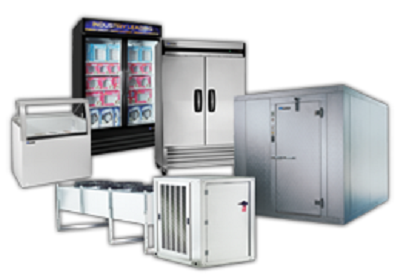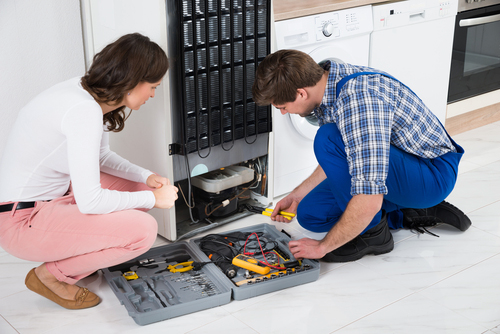Protect Your Investment with Dependable Refrigeration & Appliance Repair Service LG Appliance Repair's Expert Touch
Protect Your Investment with Dependable Refrigeration & Appliance Repair Service LG Appliance Repair's Expert Touch
Blog Article
Necessary Tips for Effective Ref Repair Service to Extend Device Lifespan
When it comes to your fridge, proper repair work and upkeep are crucial for longevity. Recognizing usual issues and understanding when to act can make all the difference.
Understanding Common Fridge Troubles
Fridges are essential in maintaining your food fresh, but they can encounter a range of usual issues that disrupt their performance. One constant problem is insufficient air conditioning. If you observe food ruining quicker than usual, examine the thermostat settings or think about if the door seals are damaged. One more typical problem is too much noise, which can indicate a malfunctioning compressor or a stopping working fan. You could additionally experience water merging inside or underneath the fridge; this usually results from a clogged up defrost drain or a faulty water line. Furthermore, if your fridge's light isn't working, it can be a basic bulb concern or a trouble with the door button. Finally, ice accumulation in the fridge freezer can prevent air movement and cooling efficiency. Identifying these problems early can conserve you time and money out of commission, guaranteeing your refrigerator runs efficiently and effectively.
Normal Upkeep Practices
To maintain your appliances running efficiently, you need to remain on top of routine upkeep methods. Tidy the condenser coils, inspect the door seals, and keep an eye on the temperature level settings to ensure peak performance. These basic tasks can save you money and time on repair services down the line.
Clean Condenser Coils Consistently
Cleansing your condenser coils consistently can substantially boost your device's performance. Dirt and dust construct up on these coils over time, creating your device to function tougher and eat even more energy. To maintain them tidy, disconnect your home appliance and very carefully eliminate any protective covers.
Check Door Seals
Three simple steps can help you assure your appliance's door seals are in good condition. 2nd, tidy the seals making use of warm, soapy water to remove any debris or crud. By following these steps, you'll maintain your device's performance and long life, saving you cash on power expenses and repairs in the long run.
Display Temperature Level Settings
Consistently checking your device's temperature level setups is necessary for finest performance and effectiveness. Whether you're taking care of a refrigerator, fridge freezer, or stove, watching on these settings can stop several issues. For fridges, aim for temperatures in between 35 ° F and 38 ° F; for freezers, linger 0 ° F. If the temperatures are also high or reduced, your home appliance may work harder, squandering power and reducing its lifespan. Make use of a thermometer to check these setups consistently, specifically after major adjustments, like moving your appliance or readjusting the thermostat. If you observe fluctuations, readjust the settings as necessary and seek advice from the individual manual for advice. By staying aggressive regarding temperature monitoring, you'll ensure your appliances run smoothly and last much longer.
Troubleshooting Air Conditioning Issues
When your fridge isn't cooling down effectively, it can result in spoiled food and threw away cash, so resolving the issue promptly is vital. Begin by checking the temperature settings to verify they go to the suggested levels, typically around 37 ° F for the refrigerator and 0 ° F for the fridge freezer. If the settings are correct, evaluate the door seals for any gaps or damage; a defective seal can permit cozy air to get in.
Inspect the condenser coils, normally situated at the back or base of the device. Tidy them with a vacuum cleaner or brush to enhance performance. If problems continue, it might be time to call a professional.
Fixing Water Leak and Ice Build-Up
If you're dealing with water leakage or ice build-up in your home appliance, it's important to identify the source of the issue. By pinpointing where the water is coming from, you can protect against additional concerns and prevent costly fixings. Let's discover some efficient techniques to take on these typical troubles.
Determine Leak Sources
How can you successfully determine the sources of water leak and ice build-up in your devices? Start by evaluating the seals and gaskets on your refrigerator and fridge freezer doors. A worn or broken seal can allow cozy air to get in, causing condensation and ice. Next off, check the drainpipe pan and drainage system for blockages or clogs; a backed-up drain can bring about water pooling. Seek any kind of loose links in the supply of water line, which can develop leaks. Examine the defrost drain for ice build-up, which could interrupt proper drainage. By systematically inspecting these locations, you'll pinpoint the resource of the problem, permitting you to take the necessary actions to repair it and prolong your check my source device's life expectancy.
Protect Against Ice Formation
To avoid ice formation in your appliances, begin by verifying the temperature level settings are proper. If your refrigerator or freezer is too cold, it can result in extreme ice accumulation. Check the door seals frequently; damaged seals can let warm air in, causing condensation and ice formation.
Keep the home appliance well-ventilated and prevent overcrowding, as this can obstruct airflow - Dependable Refrigeration & Appliance Repair Service LG Appliance Repair. Regularly defrost your fridge freezer if it doesn't have an automatic defrost feature.
If you see water leakage, identify and deal with any kind of obstructed drainage openings, as they can contribute to ice buildup. Finally, clean the coils and verify they're operating effectively to maintain peak performance. Taking these actions will assist extend your device's life expectancy and effectiveness.
Dealing With Noisy Fridge Sounds
While it could seem disconcerting, a noisy fridge often indicates site here minor concerns instead of major breakdowns. Recognize the source of the sound. Common wrongdoers consist of the compressor, followers, and water lines. If you hear a buzzing noise, it may be the compressor striving; this can just be a regular operation audio.
Following, look for loose items inside. Often, containers or racks can rattle, creating undesirable sound. Tighten up or rearrange them to eliminate the noises.
If you see a clicking noise, it could be the defrost timer. This is commonly harmless however can show it requires assessment.
Lastly, verify your fridge is degree. An out of balance home appliance can produce vibrations and noise. Use a level to examine, and readjust the feet if required. Addressing these issues quickly can help maintain your fridge's efficiency and extend its life expectancy.
When to Change Parts vs. Complete Replacement

Nonetheless, if your home appliance is older and experiencing several issues, a full replacement could be more cost-efficient. Think about the expense of repair services versus the device's value. If repairs exceed 50% of a brand-new device's cost, it's typically wiser to purchase a substitute. In addition, if you notice recurring issues that keep recurring, it's an indication that your device has actually gotten to the end of its life. Evaluate these aspects carefully to make the very best choice for your needs and budget plan.
Knowing When to Call a Professional
How can you inform when it's time to call in a specialist for device fixing? If your home appliance quits working completely or frequently journeys circuit breakers, it's read what he said another red flag.
You must additionally consider your very own convenience level with fixings. If you're unclear regarding diagnosing the issue or lack the right devices, it's finest to reach out for help. Remember, trying difficult repair services can result in more damage or even security dangers.

Regularly Asked Questions
Exactly how Typically Should I Tidy the Fridge Coils?
You must cleanse your refrigerator coils every 6 months. This helps maintain effectiveness and protects against getting too hot. If you discover extreme dirt or pet hair, clean them a lot more frequently to ensure your refrigerator runs smoothly.

Can I Use Vinegar for Cleaning My Refrigerator?
Yes, you can make use of vinegar to clean your fridge! It's an excellent natural cleaner that gets rid of smells and spots. Appliance Repair Oro Valley Dependable Appliance Services. Simply blend it with water, use it to surfaces, and clean down for a fresh, tidy refrigerator
What Temperature Should My Fridge Be Ready To?
You need to establish your fridge to 37 ° F(3 ° C) for suitable food preservation. This temperature maintains your food fresh while avoiding spoilage, guaranteeing your grocery stores last much longer and reducing waste. It's a very easy change you can make!
Does a Fridge Need to Be Leveled?
Yes, your fridge requires to be leveled. If it's irregular, it can influence cooling down effectiveness and create excess sound. Examine the leveling legs and adjust them to assure appropriate balance for optimal efficiency.
Exactly How Can I Lower Refrigerator Power Consumption?
To reduce your fridge's power usage, keep it tidy and well-ventilated, inspect door seals for leaks, established the temperature level between 35-38 ° F, and prevent straining it. These actions can substantially decrease your energy bills.
Report this page